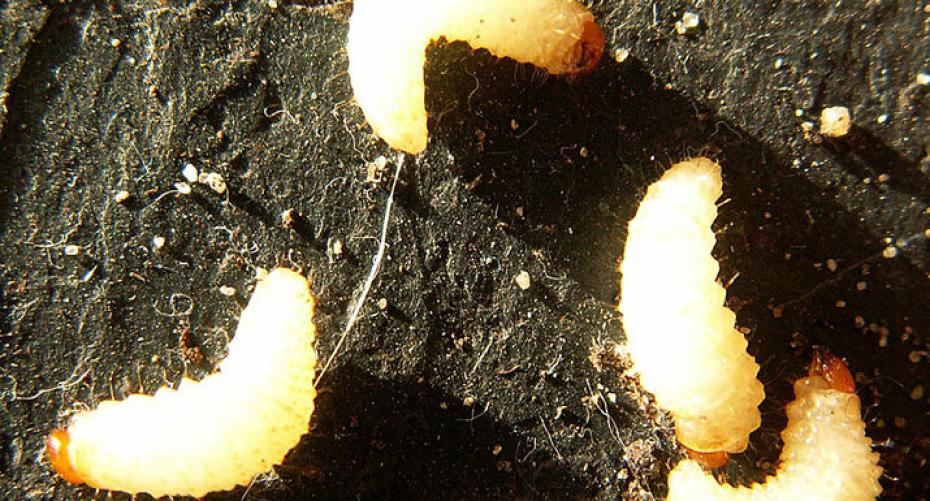Be vigilant and catch these pests before they destroy your plants
Image above courtesy of Opuntia
The vine weevil (Otiorhynchus sulcatus) is absolutely dreaded by gardeners as it can devastate the garden and control is really difficult and often needs a combination of measures. The adult beetle will chew the leaves, which doesn’t really harm the plant but it is the grubs which are destructive, they eat the roots and burrow into bulbs and corms. Pots and containers seem to be particularly favoured by these pests but they can also be found in open ground, raised beds and on indoor plants. Plants most susceptible are: Bergenia, Camellia, Epimedium, Euonymus, Fuchsia, Hellebores, Hydrangea, Primula, Rhododendrons, Rosemary and Strawberries.
Vine weevil are often introduced into your garden through new plants bought from a garden centre so before you plant them have a quick look through the roots. If you find grubs return the plant to the garden centre immediately, if you can’t do that straight away isolate the plant by placing the whole thing in a bin liner in case it also contains any adult beetles.
The first signs that you have vine weevil can be:
- Notches chewed out of the edges of leaves.
- Catching sight of the adult beetles; which are flightless, dull dark brown/black with dull creamy mustard markings. These are active at night and usually found between spring and late summer.
- Wilted or dead plants are often the first signs and by then it is often too late.
If you see any of the above symptoms take the plant out of the container and check in the roots for grubs which are tiny cream C-shaped grubs with a gingery brown head. If the plant has a woody stem also check around the stem at soil level which will be chewed all the way around. These grubs do most damage from summer to spring.
Prevention:
- Encourage natural predators such as predatory ground dwelling beetles, frogs and toads, birds, hedgehogs and shrews. So feed the birds, introduce a small natural pond if possible and leave a bit of the garden unkempt as a refuge for insects and small mammals.
- Place a ring of sticky trap tape around pots.
- Go out at night with a torch to try and spot the adult beetles.
- Keep the greenhouse tidy and keep checking the undersides of shelving or staging and underneath pots.
You may have to apply more than one of the following methods of removal once you’ve detected them:
- Nematodes are the most environmentally friendly method of controlling the grubs; they work by infecting the grubs with a bacteria which causes a fatal infection. Apply them to the soil as soon as you receive them as they are a living organism. August and September are the best months to apply the nematodes as the soil has warmed up nicely providing optimum conditions for them to thrive. They are not very effective on heavy or dry soils preferring a nice open light compost. Try Nemasys Vine Weevil Killer.
- Drench the soil close to the plant stem with an insecticide such as Bio Provado Vine Weevil Killer 2 or Bug Clear Ultra Vine Weevil Killer. These are not to be used on edible crops.
- Go out at night with a torch to spot the beetles feeding.
- Place sheets of newspaper underneath shrubs at night and give the plant a shake to dislodge the beetles.
- Check underneath the greenhouse staging and any pots.
Once you have found the grubs in your pots dispose of the compost in the grey refuse bin, not the recycling bin or the compost heap, and if the plant has any roots left give them a good wash in a bucket of water then dispose of it down the drain. Check the roots and if you are 100% convinced there are no grubs left repot in a clean pot with new compost. Scrub out the old pot with a solution of Jeyes Fluid and rinse thoroughly before reusing.




![Kingsbury-bench-05[1].jpg](http://www.hayesgardenworld.co.uk/cdn/shop/files/Kingsbury-bench-05_5B1_5D.jpg?v=1712162737&width=1500)
![Kingsbury-bench-01[1].jpg](http://www.hayesgardenworld.co.uk/cdn/shop/files/Kingsbury-bench-01_5B1_5D.jpg?v=1712161065&width=1500)
![tw17a-4947_0[1].jpg](http://www.hayesgardenworld.co.uk/cdn/shop/files/tw17a-4947_0_5B1_5D.jpg?v=1712161495&width=1500)
![tw17a-4947_tenbury_5ft[1].jpg](http://www.hayesgardenworld.co.uk/cdn/shop/files/tw17a-4947_tenbury_5ft_5B1_5D.jpg?v=1712161172&width=1500)
![tw17a-4952_tenbury_4ft[1].jpg](http://www.hayesgardenworld.co.uk/cdn/shop/files/tw17a-4952_tenbury_4ft_5B1_5D.jpg?v=1712161034&width=1500)
![thumbnail_IMG_1565-kik_2[1].jpg](http://www.hayesgardenworld.co.uk/cdn/shop/files/thumbnail_IMG_1565-kik_2_5B1_5D.jpg?v=1712226536&width=1500)
![thumbnail_IMG_1565-kik_1[3].jpg](http://www.hayesgardenworld.co.uk/cdn/shop/files/thumbnail_IMG_1565-kik_1_5B3_5D.jpg?v=1712159637&width=1500)



![WD-XgESA[1].jpeg](http://www.hayesgardenworld.co.uk/cdn/shop/files/WD-XgESA_5B1_5D.jpg?v=1712159609&width=1500)